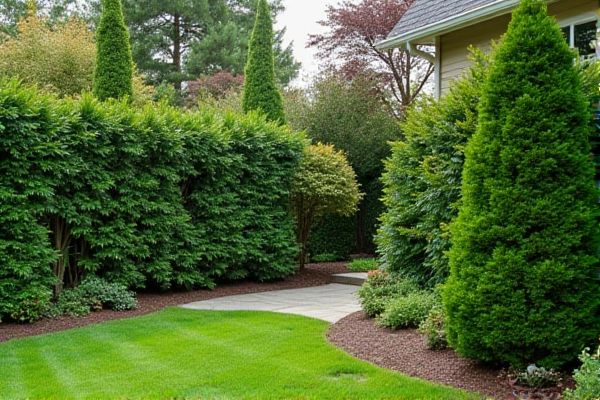
Boxwood hedges offer dense, evergreen foliage with a slow growth rate, making them ideal for formal garden designs and precise shaping. Privet hedges grow faster and provide thick, leafy coverage perfect for privacy screens; explore our detailed comparison to discover which hedge best suits Your landscaping needs.
Table of Comparison
| Feature | Boxwood Hedge | Privet Hedge |
|---|---|---|
| Scientific Name | Buxus sempervirens | Ligustrum spp. |
| Growth Rate | Slow to moderate (6-12 inches/year) | Fast (1-3 feet/year) |
| Height | Typically 2-6 feet, up to 15 feet | 3-15 feet, can grow taller |
| Leaf Type | Small, glossy, evergreen leaves | Medium, oval, semi-evergreen to deciduous leaves |
| Climate Preference | Temperate zones, hardy USDA zones 5-9 | Wide range, USDA zones 5-9, tolerates heat and humidity |
| Maintenance | Low; requires occasional trimming | Moderate to high; frequent pruning needed |
| Pest Resistance | Moderate; susceptible to boxwood blight and mites | High; generally resistant but can attract aphids |
| Uses | Formal gardens, borders, topiary | Privacy screens, windbreaks, wildlife habitat |
| Soil Preference | Well-drained, slightly acidic to neutral | Adaptable, tolerates various soil types |
| Sunlight | Partial to full sun | Full sun to partial shade |
Introduction to Boxwood and Privet Hedges
Boxwood hedges, derived from the Buxus genus, are evergreen shrubs prized for their dense, slow-growing foliage and ability to be shaped into formal, structured designs. Privet hedges, from the Ligustrum genus, grow faster and offer a more informal appearance with abundant small leaves and white spring flowers that attract pollinators. Both hedges serve as popular choices for privacy screens and garden borders, but boxwood is favored for precision topiary, while privet excels in quick growth and seasonal interest.
Appearance and Visual Appeal
Boxwood hedges offer a dense, compact appearance with small, glossy leaves providing a refined and formal look ideal for classic garden designs. Privet hedges feature larger, oval-shaped leaves and a more open growth pattern, giving a natural, slightly informal aesthetic that suits casual or mixed shrub borders. Your choice between these hedges can significantly influence the overall texture and visual structure of your landscape.
Growth Rate and Maintenance Requirements
Boxwood hedges grow slowly, requiring patience and consistent pruning to maintain their dense, compact form, ideal for formal garden designs. Privet hedges exhibit a faster growth rate, making them suitable for quickly establishing privacy screens but demanding more frequent trimming to control their vigorous spread. Your choice depends on whether you prefer a low-maintenance, slow-growing hedge or a rapidly growing option that needs regular upkeep.
Climate and Soil Preferences
Boxwood hedges thrive in well-drained, slightly acidic to neutral soils and are best suited for temperate climates with moderate humidity. Privet hedges are more adaptable, tolerating a wider range of soil types, including clay and alkaline soils, and can withstand hotter climates and variable moisture levels. Your choice between boxwood and privet should consider local climate conditions and soil characteristics to ensure optimal growth and hedge density.
Pest and Disease Resistance
Boxwood hedges demonstrate strong resistance to common pests such as boxwood leafminers and boxwood blight, although they require attentive care to prevent these issues. Privet hedges are generally hardy with fewer significant pest threats, but can be susceptible to scale insects and powdery mildew in humid conditions. Choosing between the two depends on local pest prevalence and the gardener's ability to manage potential infestations effectively.
Pruning and Shaping Capabilities
Boxwood hedges offer excellent pruning and shaping capabilities, allowing for precise, formal designs and intricate topiary work due to their dense, small leaves and slow growth rate. Privet hedges grow faster and respond well to regular pruning, making them ideal for creating quick, natural-looking privacy screens, but they require more frequent trimming to maintain a tidy shape. Your choice depends on whether you prefer a low-maintenance, sculpted hedge like boxwood or a faster-growing, versatile option like privet.
Lifespan and Durability
Boxwood hedges typically have a longer lifespan, often thriving for several decades with proper care, due to their dense growth and resistance to pests. Privet hedges grow faster but generally have a shorter lifespan, usually around 10 to 15 years, and may require more frequent maintenance to prevent disease and thinning. Boxwood's durability makes it ideal for formal, long-lasting hedging, whereas privet suits quicker establishment despite its relatively limited longevity.
Privacy and Noise Reduction
Boxwood hedges provide dense, evergreen foliage that effectively enhances privacy and offers moderate noise reduction, making them suitable for residential gardens seeking quiet seclusion. Privet hedges grow rapidly with thick branches and leaves, creating a robust barrier that excels in both visual screening and sound dampening, often preferred for urban areas with higher noise levels. The choice between the two depends on desired growth rate, maintenance levels, and the balance of privacy versus noise buffer needs.
Cost Comparison and Availability
Boxwood hedges typically have a higher initial cost due to their slower growth and greater maintenance needs, while privet hedges are more affordable and readily available at most garden centers. Privet plants grow faster, offering quicker hedge formation, reducing labor expenditure over time. Your choice depends on budget constraints and how soon you want a dense, mature hedge.
Choosing the Best Hedge for Your Landscape
Boxwood hedges provide dense, evergreen foliage and excellent shaping versatility, making them ideal for formal gardens and year-round structure. Privet hedges grow faster and offer lush, green coverage, perfect for privacy screens and informal hedgerows. Evaluate your landscape's maintenance needs, growth speed preferences, and desired hedge style to choose the best option for your yard.
 homyna.com
homyna.com